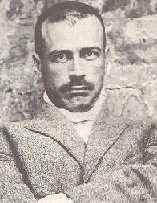Spadina Literary Review — edition 3 page 04
re verse
Living the dream:
the case of Emile Nelligan
article and translations by Ian Allaby
His masts touched the sky, he sailed on unknown seas — so his gravestone in Côte-des-Neiges cemetery tells us. But does it speak true? He has been called the finest poet in 19th-century Canada, but was that a tough contest to win? Perhaps the one thing we can say with confidence about Emile Nelligan is that he was Canada’s first modern poet. In an era when the reigning bards were either nature nambies or tribal tub-thumpers, Nelligan was fixated on his personal emotional issues. This type of self-centredness eventually became appreciated and even celebrated. But Nelligan was still a kid, don’t forget. Given time, he might actually have earned his epitaph — had he not broken down at age 19 and spent the last forty-two years of his life in mental hospitals.

Nelligan at age 41
in his 22nd year
at St. Benoît asylum.
He was born on Christmas Eve in 1879, son of Emilie Hudon, a Rimouski girl with a gift for the piano, and of David Nelligan, an Irish immigrant who had landed a spot as a post office inspector. Young Emile was educated in French-language Catholic schools in Montreal and it was in that environment that poetry bit him at age 13.
He published his first poem in 1896 at age 16. In short order, poetry became his single-minded vocation, to the exclusion of all other types of ambition and all other methods of learning. Schoolbooks, for example, being typically not written in verse, were to him useless. By mid-1899, altho it would be a stretch to say that Nelligan had established his name outside of a small circle, he at least had published almost two dozen poems, with about 150 more waiting in his notebooks.